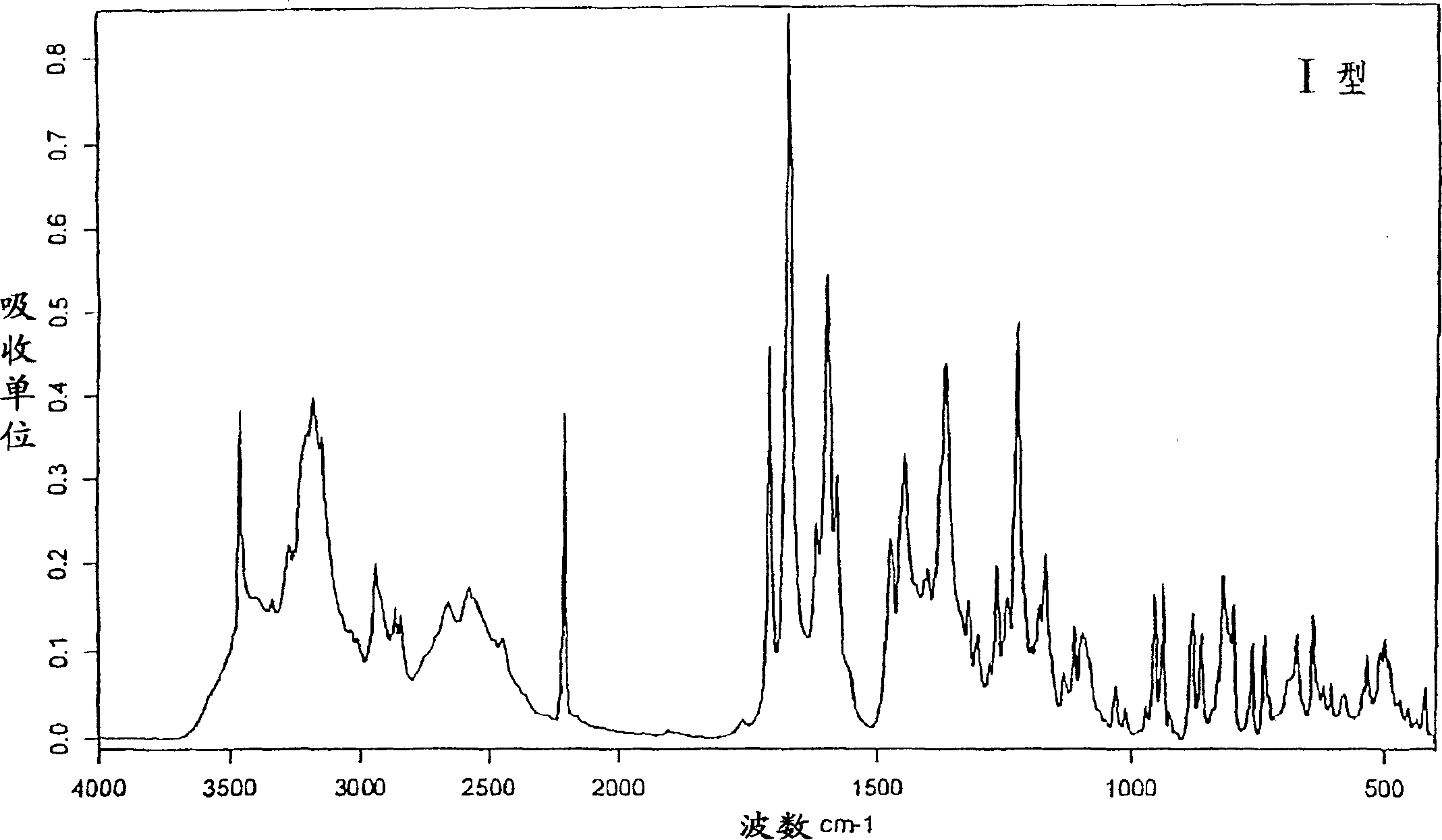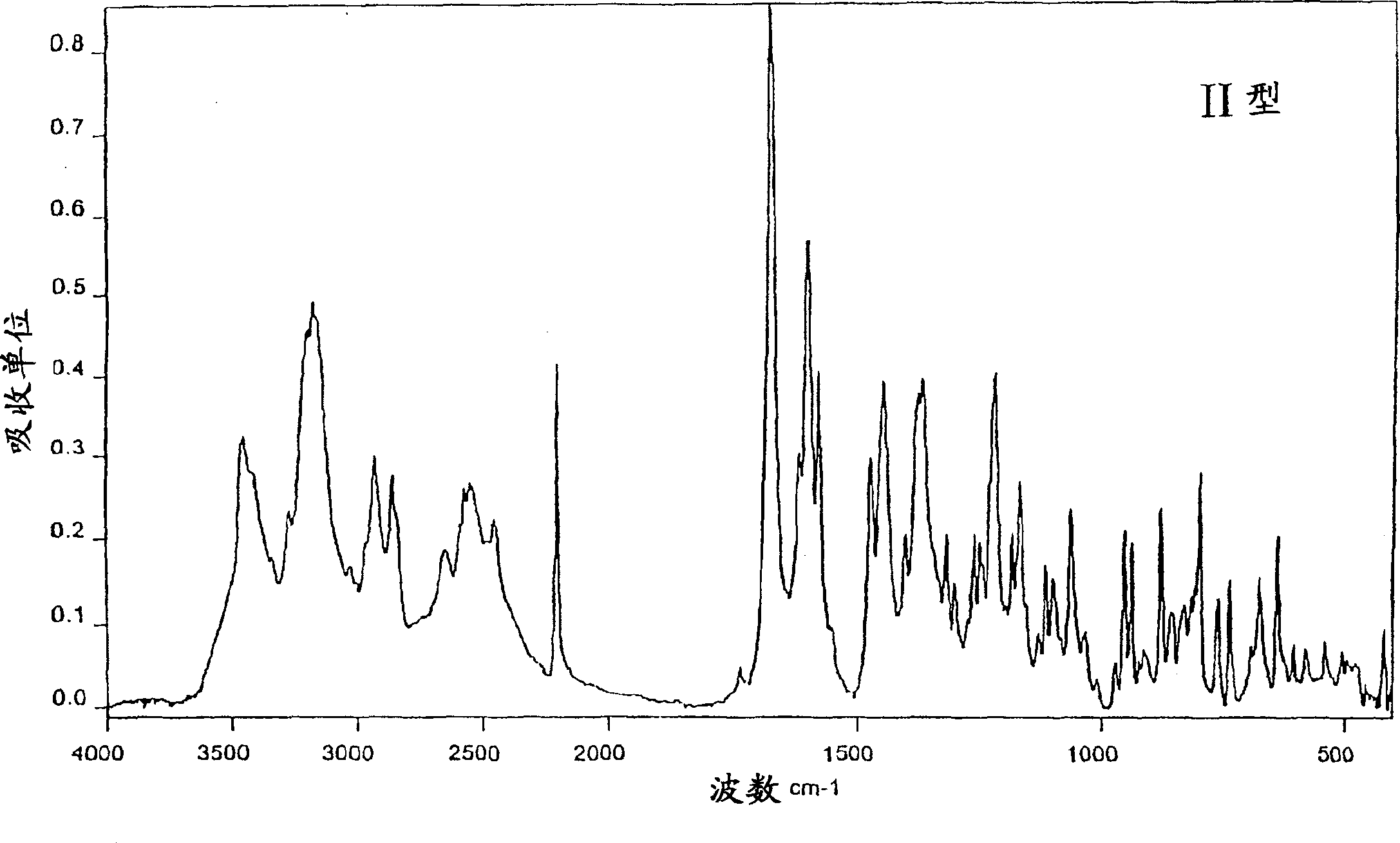Polymorphic forms of 1-4-(5-cyanoindol-3-yl) butyl-4-(2-carbamoylbenzofuran-5-yl) piperazine hydrochloride
A technology of cyanindole and benzofuran, which is applied in the field of treatment of medical diseases and can solve the problems of incomparability
- Summary
- Abstract
- Description
- Claims
- Application Information
AI Technical Summary
Problems solved by technology
Method used
Image
Examples
Embodiment 1
[0242] Preparation of type I 1-[4-(5-cyanindol-3-yl)butyl]-4-(2-carbamoyl-benzofuran-5-yl)-piperazine hydrochloride
[0243] method 1:
[0244] 1 g of 1-[4-(5-cyanindol-3-yl)butyl]-4-(2-carbamoyl-benzofuran-5-yl)-piperazine was dissolved in 80 ml of acetone. The temperature of the solution was brought to 50°C, and 0.5 ml of 1N hydrochloric acid was added to the reaction mixture. After stirring for 2 to 3 minutes, the reaction mixture was cooled to room temperature and a precipitate appeared. The precipitated crystals were filtered with suction. Drying in vacuo at room temperature to constant weight gave 1-[4-(5-cyanindol-3-yl)butyl]-4-(2-carbamoyl-benzofuran-5-yl)-piper Oxazine hydrochloride acetonide type I.
[0245] Method 2:
[0246] Disperse 2.25 g of 1-[4-(5-cyanindol-3-yl)butyl]-4-(2-carbamoyl-benzofuran-5-yl)-piperazine hydrochloride Type III in 200ml acetone. After stirring for 14 days, the precipitated crystals were recovered by filtration and dried in vacuum a...
Embodiment 2
[0248] Preparation of type II 1-[4-(5-cyanindol-3-yl)butyl]-4-(2-carbamoyl-benzofuran-5-yl)-piperazine hydrochloride
[0249] method 1:
[0250] 1g 1-[4-(5-cyanindol-3-yl)butyl]-4-(2-carbamoyl-benzofuran-5-yl)-piperazine was dissolved in 46.6g tetrahydrofuran, and To the reaction mixture was added 2.2 g of 1N hydrochloric acid. After settling and stirring for 30 minutes, the precipitated crystals were filtered with suction. Drying in vacuo at room temperature to constant weight gave 1-[4-(5-cyanindol-3-yl)butyl]-4-(2-carbamoyl-benzofuran-5-yl)-piper A solvate type II of oxazine hydrochloride and tetrahydrofuran, which presents figure 2 The IR absorption spectrum and Figure 13 X-ray diffraction spectrum.
[0251] Method 2:
[0252] Disperse 3 g of 1-[4-(5-cyanindol-3-yl)butyl]-4-(2-carbamoyl-benzofuran-5-yl)-piperazine hydrochloride type III in 400ml tetrahydrofuran. After stirring for 20 days, the precipitated crystals were recovered by filtration. Drying in vacuo a...
Embodiment 3
[0254] Preparation of Type XV 1-[4-(5-cyanindol-3-yl)butyl]-4-(2-carbamoyl-benzofuran-5-yl)-piperazine hydrochloride
[0255]At 0°C, to 1-[4-(5-cyanindol-3-yl)butyl]-4-(2-carbamoyl-benzofuran-5-yl)-piperazine hydrochloride A solution of tetrahydrofuran (200ml) (molar ratio of base to tetrahydrofuran = 1:48) was added to 10ml of 1N hydrochloric acid. After stirring for 30 minutes, the precipitated crystals were recovered by filtration. Drying in vacuo at room temperature to constant weight gave 1-[4-(5-cyanindol-3-yl)butyl]-4-(2-carbamoyl-benzofuran-5-yl)-piper The solvate type XV of oxazine hydrochloride and tetrahydrofuran, which presents image 3 The IR absorption spectrum and Figure 14 X-ray diffraction spectrum.
PUM
 Login to View More
Login to View More Abstract
Description
Claims
Application Information
 Login to View More
Login to View More - R&D
- Intellectual Property
- Life Sciences
- Materials
- Tech Scout
- Unparalleled Data Quality
- Higher Quality Content
- 60% Fewer Hallucinations
Browse by: Latest US Patents, China's latest patents, Technical Efficacy Thesaurus, Application Domain, Technology Topic, Popular Technical Reports.
© 2025 PatSnap. All rights reserved.Legal|Privacy policy|Modern Slavery Act Transparency Statement|Sitemap|About US| Contact US: help@patsnap.com



